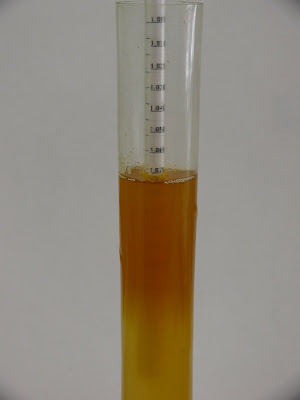To my surprise, the Pilsner lager that I recently brewed back in February is getting low. One of the problems with lighter colored beers is that 1) they're so easy to drink and 2) everybody likes them, so when someone comes over and you offer them a beer....they want more....so it goes quickly. This is a good thing actually and this is one of my favorite styles so I'd like to keep brewing it to improve the recipe as I always learn something from each batch to tweak the next time. So, now that I realized I'd be out of Pilsner soon I had to come up with something to replace it. After looking at what Ingredients I had on hand I decided to brew something with what I had available. I had enough of the right ingredients to do either a less hoppy German Pilsner or a Munich Helles. The decision on what to brew came down to the yeast available to me, since I wanted to use the yeast cake from the Oktoberfest which just finished in the primary fermenter. This is a Bavarian Lager yeast which is best suited for malt focused German lagers. Since I wanted to try a different yeast strain for my next Pilsner and since I didn't have enough hops to make a hoppy version of Pilsner I decided to go with the Munich Helles, which this yeast should work very well with.
The Recipe
I again wanted to keep the recipe simple and went with a pretty basic grain bill. Pilsner malt makes up 95% of the malt with German Light Munich malt making up the remaining 5%. This should make very pale beer with the the Munich malt addition mainly to give some extra maltiness that a decoction mash would bring without actually doing a decoction. German Hallertau hops were used at first wort and in 2 other small additions during the boil to give the beer a subdued but hopefully still noticeable low hop flavor and also enough bitterness to balance the malts sweetness. A final addition of Czech Saaz hops was added at the end to give a slight hop aroma to the beer. In order to make a beer this light, soft water must be used and 90% of the mash water was soft water filtered through reverse osmosis with some adjustment to Calcium content made by Calcium Chloride and Gypsum brewing salts. As you can see in the picture below, the color is very light with an original gravity reading around 1.052. This beer should be ready by the middle of May, just in time for the hopefully warmer weather as it should be a thirst quencher! The full recipe is posted below the picture.

HoenischBrau Helles
1-D Munich Helles
Author: Bob Hoenisch
Date: 4/2/2009
Size: 5.6 gal
Efficiency: 85.8%
Attenuation: 77.0%
Calories: 164.21 kcal per 12.0 fl oz
Original Gravity: 1.050 (1.045 - 1.051)
====================#===========
Terminal Gravity: 1.011 (1.008 - 1.012)
=====================#==========
Color: 3.92 (3.0 - 5.0)
===============#================
Alcohol: 5.0% (4.7% - 5.4%)
==============#=================
Bitterness: 20.6 (16.0 - 22.0)
====================#===========
Ingredients:
9.0 lb Pilsner Malt
8.0 oz German Light Munich
1.0 oz Hallertau Hersbruck (3.5%) - added first wort, boiled 90 min
20 g Hallertau Hersbruck (3.5%) - added during boil, boiled 20.0 min
20.0 g Hallertau Hersbruck (3.5%) - added during boil, boiled 10.0 min
.5 oz Czech Saaz (2.5%) - added during boil, boiled 0.0 min
1.0 ea WYeast 2206 Bavarian Lager
Schedule:
Ambient Air: 45.0 °F
Source Water: 55.0 °F
Elevation: 3500.0 ft
00:05:00 Mash in - Liquor: 5.0 gal; Strike: 158.59 °F; Target: 150.0 °F
01:05:00 Saccrification Rest - Rest: 60.0 min; Final: 148.6 °F
02:05:00 sparge - Sparge Volume: 5.0 gal; Sparge Temperature: 168.0 °F; Runoff: 6.77 gal











